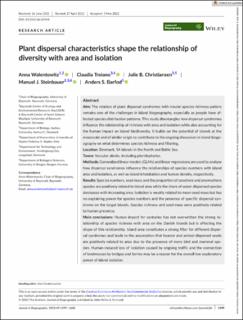| dc.contributor.author | Walentowitz, Anna | |
| dc.contributor.author | Troiano, Claudia | |
| dc.contributor.author | Christiansen, Julie B. | |
| dc.contributor.author | Steinbauer, Manuel | |
| dc.contributor.author | Barfod, Anders S. | |
| dc.date.accessioned | 2023-03-01T13:03:49Z | |
| dc.date.available | 2023-03-01T13:03:49Z | |
| dc.date.created | 2022-10-04T09:47:01Z | |
| dc.date.issued | 2022 | |
| dc.identifier.issn | 0305-0270 | |
| dc.identifier.uri | https://hdl.handle.net/11250/3055017 | |
| dc.description.abstract | Aim
The relation of plant dispersal syndromes with insular species richness patters remains one of the challenges in island biogeography, especially as people have affected species distribution patterns. This study disentangles how dispersal syndromes influence the relationship of richness with area and isolation while also accounting for the human impact on island biodiversity. It builds on the potential of islands at the mesoscale and of similar origin to contribute to the ongoing discussion in island biogeography on what determines species richness and filtering.
Location
Denmark, 54 islands in the North and Baltic Sea.
Taxon
Vascular plants, including pteridophytes.
Methods
Generalized linear models (GLMs) and linear regressions are used to analyse how dispersal syndromes influence the relationships of species numbers with island area and isolation, as well as island inhabitation and human density, respectively.
Results
Species numbers, seed mass and the proportion of zoochore and anemochore species are positively related to island area while the share of water-dispersed species decreases with increasing area. Isolation is weakly related to mean seed mass but has no explaining power for species numbers and the presence of specific dispersal syndrome on the target islands. Species richness and seed mass were positively related to human presence.
Main conclusions
Human impact for centuries has not overwritten the strong relationship of species richness with area on the Danish Islands but is affecting the shape of this relationship. Island area constitutes a strong filter for different dispersal syndromes and leads to the assumption that heavier and animal-dispersed seeds are positively related to area due to the presence of more bird and mammal species. Human-induced loss of isolation caused by ongoing traffic and the connection of landmasses by bridges and ferries may be a reason for the overall low explanatory power of island isolation. | en_US |
| dc.language.iso | eng | en_US |
| dc.publisher | Wiley | en_US |
| dc.rights | Attribution-NonCommercial-NoDerivatives 4.0 Internasjonal | * |
| dc.rights.uri | http://creativecommons.org/licenses/by-nc-nd/4.0/deed.no | * |
| dc.title | Plant dispersal characteristics shape the relationship of diversity with area and isolation | en_US |
| dc.type | Journal article | en_US |
| dc.type | Peer reviewed | en_US |
| dc.description.version | publishedVersion | en_US |
| dc.rights.holder | Copyright 2022 The Author(s) | en_US |
| cristin.ispublished | true | |
| cristin.fulltext | original | |
| cristin.qualitycode | 2 | |
| dc.identifier.doi | 10.1111/jbi.14454 | |
| dc.identifier.cristin | 2058194 | |
| dc.source.journal | Journal of Biogeography | en_US |
| dc.source.pagenumber | 1599-1608 | en_US |
| dc.identifier.citation | Journal of Biogeography. 2022, 49 (9), 1599-1608. | en_US |
| dc.source.volume | 49 | en_US |
| dc.source.issue | 9 | en_US |

